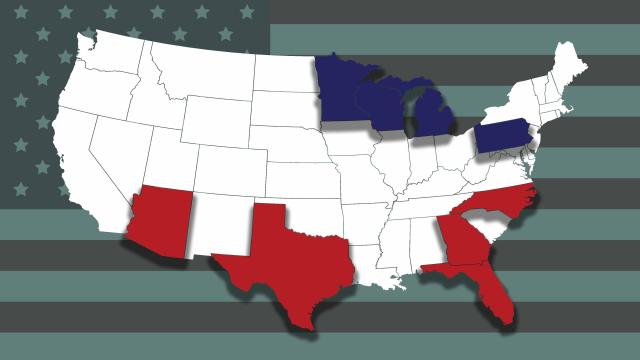
(Source: HartEnergy.com)
Forget what you’ve heard about the importance of Pennsylvania, Wisconsin and Michigan in the presidential election. On election night, focus on these five states—Texas, Arizona, Florida, North Carolina and Georgia—a political analyst advised attendees at an Independent Petroleum Association of America webinar on Oct. 15.
Why? Because if former Vice President Joe Biden wins any one of them, he will become the next president.
For the oil and gas industry, Trump’s re-election would mean a continuation of federal deregulation. A Biden presidency would likely accelerate the energy transition toward cleaner fuels and renewable sources such as wind and solar.
Opinion: How US Fracking Could Be an Unlikely Beneficiary of a 'Blue Wave'
Oil and Gas Investor Policy Outcomes: Energy and the Election
“[Arizona, Texas and Georgia] were rock-solid Republican states and they were actually in the same category as New York, New Jersey and California for a Democrat—they were a given, they were conceded,” said Jim Ellis, a former Republican operative and now a consultant. “But not anymore. These three states are moving closer to the political center. Now, Republicans are going to win more votes here, still, than Democrats, but they are much more competitive and can’t be taken for granted.”
Winning those five states, which Ellis calls “Trump’s Core Five,” opens up a path to re-election for President Donald Trump, he said, because it forces Biden to successfully defend all of the Great Lakes states that are traditional Democratic strongholds but which its presidential nominee, Hillary Clinton, failed to win in 2016. Those states are Minnesota, Wisconsin, Michigan and Pennsylvania.
Trump’s Core Five
At this point, Biden holds slim leads in all of the five southern states except Texas, but Ellis doesn’t see the numbers as particularly bad for Trump. He devised a system based on the five most recent polls in key states. When he compares his polling now with the polling at the same point in 2016, there are a lot of similarities.
Here is how the states look.
Arizona (11 electoral votes): Trump was even with Clinton in mid-October 2016, Ellis said. He trails Biden by a statistically insignificant 1.5 percentage points this year.
FiveThirtyEight.com, an analytical website run by Nate Silver and owned by ABC News, says Biden is slightly favored to win, based on a formula relying 74% on polls and 26% on demographics and prior voting patterns. A highly regarded Oct. 9-13 poll by Monmouth University had Biden up 50% to 46%. In 2016, Trump won with 49.5% of the vote to Clinton’s 45.4%.
If anything should keep Trump and his campaign team up at night, it’s Arizona, Ellis said.
Georgia (16): Trump led Clinton by 4 points and is 1 point behind Biden. Ellis noted demographic changes in Georgia that favor Democrats but believes that polling is undercounting Republicans.
FiveThirtyEight has Georgia, where Trump was a strong favorite at the end of August, as a toss-up. The most recent poll from SurveyUSA gave Biden a slight lead. Trump won with 51.3% in 2016.
North Carolina (15): Biden has a 3-point mid-October lead over Trump. Clinton led by the same margin in 2016. FiveThirtyEight has Biden as a slight favorite since the race was a toss-up at the start of October. SurveyUSA has Biden up by 5 and Sienna College/New York Times has Biden up by 4. Trump won with 50.5% in 2016.
Florida (29): This is a critical state that has been tough for pollsters to gauge. Biden’s mid-October lead is 2 points, a slimmer margin than Clinton’s 4. FiveThirtyEight says Biden is favored to win and projects a final tally of 51.2% to 48%. In 2016, Trump edged Clinton, 49.1% to 47.8%.
“Florida and North Carolina are actually a bit worse at this point in time than 2016 but Trump rebounded to win them both,” Ellis said. “That’s kind of typical. The pollsters cumulatively have missed the last three statewide elections in Florida: Trump 2016, governor and senate campaigns in 2018. That tells us there is an undercount for the Republicans in the polling in that state.”
Texas (38): The Republican bastion was such a long shot for Clinton in 2016 that pollsters largely ignored it. No more. Trump has a 2.5-point advantage in the state, Ellis said. Texas is moving leftward toward the center but probably not enough to sway this election.
FiveThirtyEight no longer considers Texas one of its states to watch, calculating that Trump has a 69% chance of winning. Trump won in 2016 with a closer-than-expected 52.6% to Clinton’s 43.4%.
Ellis’s take on the Core Five: “Trump is actually in a little better shape than the public polls suggest.”
Great Lakes Repeat?
Successfully defending those five states sets up the math for Trump to win re-election by winning one of the four Great Lakes states. It won’t be easy because Biden holds strong leads in all four. However, those leads are not as strong as Clinton’s mid-October 2016 leads when she lost three of them and nearly lost Minnesota.
Pennsylvania (20): Ellis has Biden up by 5 points in mid-October, less than Clinton’s 8 points. FiveThirtyEight has Biden favored but in-state polls vary widely, giving the former vice president leads that range from 2 to 13 points. The projection has Biden winning with 52.8% of the vote. Ellis believes that Pennsylvania is Trump’s best bet to win a Great Lakes state. The president won in 2016, 48.8% to 47.6%.
Michigan (16): The most recent polls that Ellis uses average out to a 7-point lead for Biden in mid-October. But mid-October 2016 polls had Clinton up by 11 points in a state that Trump won, 47.6% to 47.3%.
Wisconsin (10): Ellis has Biden up by 7 points, compared to Clinton’s 6-point lead in 2016. FiveThirtyEight’s take is that Biden is favored to win the state and projected a 53-46 result in mid-October. The Sienna College/New York Times Upshot poll has Biden up by 10 points. However, Trafalgar gives Biden only a 2-point edge, and Ellis noted that Trafalgar was the only poll that called Michigan and Pennsylvania for Trump in 2016. Trump won in 2016, 47.9%-46.9%.
Minnesota (10): No change from 2016, with 6-point mid-October leads for both Biden and Clinton. FiveThirtyEight says Biden is clearly favored to win the state and projects a vote of 53.4%-45.1%. However, Clinton barely won it, 46.9% to 45.4%, in 2016. Ellis sees the state moving more to the center from the left but doesn’t think Trump will be able to take it this year. A Republican hasn’t won Minnesota since Richard Nixon in 1972.
Poll Watching
Ellis gives credence to national polling, which has Biden leading Trump by an average of 10.5 points as of Oct. 16. Silver’s national predictions of a Clinton victory in the popular vote came true but state polling was not reliable, which is why Trump’s victory with 306 Electoral College votes came as a surprise.
That could happen again in 2020, Ellis said, because various polling methodologies are resulting in wildly different results at the state level. Pollsters have said that they have made adjustments and are accounting for the “shy Trump” voter, but Ellis has his doubts.
That said, he does point out differences between this election and the last one that are negatives for the Trump campaign.
- The COVID-19 pandemic led to a shutdown of the economy, depriving the president of his principle strength;
- The Trump campaign has struggled in this campaign to deliver a clear message to voters for why they should re-elect him;
- The president has lost significant levels of support with voters age 65 and up; and
- The public had a negative perception of Clinton, which is not the case with Biden.
Then there are the wild cards, Ellis said. Iowa and Ohio may not stay in the president’s camp, and Biden is not a lock to hold onto Nevada and New Hampshire. More voters are registered than in 2016 but how will they vote? Will they even show up to vote?
Ellis’s take, ironically for a Republican strategist, is similar to that expressed by Biden’s campaign manager, Jen O’Malley Dillon.
“We think this race is far closer than folks on this website [Twitter] think,” she told The Hill. “Like, a lot closer.”
That’s because Dillon, like Ellis, is focused on the races in battleground states that are far from certain victories.
“If the map falls the way it did in 2016, President Trump is in pretty good shape,” Ellis said. “It is still a winnable race for him if [he wins] the core Southern states, which are more of a challenge for him than they were last time, and then crack through one of these midwestern, mid-Atlantic, Great Lakes states.”
Recommended Reading
NextEra Energy Dials Up Solar as Power Demand Grows
2024-04-23 - NextEra’s renewable energy arm added about 2,765 megawatts to its backlog in first-quarter 2024, marking its second-best quarter for renewables — and the best for solar and storage origination.
BCCK, Vision RNG Enter Clean Energy Partnership
2024-04-23 - BCCK will deliver two of its NiTech Single Tower Nitrogen Rejection Units (NRU) and amine systems to Vision RNG’s landfill gas processing sites in Seneca and Perry counties, Ohio.
Clean Energy Begins Operations at South Dakota RNG Facility
2024-04-23 - Clean Energy Fuels’ $26 million South Dakota RNG facility will supply fuel to commercial users such as UPS and Amazon.
Romito: Net Zero’s Costly Consequences, and Industry’s ‘Silver Bullet’
2024-04-22 - Decarbonization is generally considered a reasonable goal when presented within the context of a trend, as opposed to a regulatory absolute.





